| This article's factual accuracy may be compromised due to out-of-date information. The reason given is: many signs are missing, vastly incomplete. Please help update this article to reflect recent events or newly available information. (May 2018) |

Road signs in Greece are regulated by the Ministry of Transport and the Hellenic Traffic Police, according to the Greek Highway Code.
Signs follow the general European conventions concerning the use of shape and colour, for every sign category. Signs indicating dangers are triangular with a red border, those giving orders are almost all circular (white on blue for mandatory instructions, black on white with a red border for prohibitions), and those providing information are rectangular. Most signs use pictograms to convey their particular meaning.
As is customary in European countries, all signs are partly or fully reflectorized or are provided with their own night-time illumination. Signs used for temporary regulations may have an bright orange background colour.
Greek road signs depict people with realistic (as opposed to stylized) silhouettes. All signs are identified by a Greek capital letter (for each category) and a number. Signs that indicate the same meaning but in a different direction have the same capital letter and number but are additionally differentiated by a lowercase letter (e.g. α, β, γ, δ, ... or α for left and δ for right).
Greece acceded to the Vienna Convention on Road Signs and Signals on December 18, 1986.
History

The history of road signaling in Greece dates back to Antiquity. The first road signaling included marble columns with the head of Hermes, protector of the wayfarers. Those signs were known as ἑρμαῖ ("Hermai"). There were also milestones for measuring street length in stadions. Similar columns were also used in Roman times, but had miles as a unit of measurement.
The first road signage on Greek roads with contemporary signs was made in 1924 by ELPA (Elliniki Leschi Periigiseon kai Aftokinitou, lit. translated: Hellenic Club of Tours and Car), which took over the road network's signage until 1957, when it was taken over by the state. The signs were subject to the provisions of the Geneva Protocol on Road Signs and Signals.
On July 25, 1962, and with Government Gazette A '110/62, it was announced in paragraph 1 of article 14 that "by joint decisions, issued by the Ministers of Transport, Public Works and Interior, all matters relating to the road signs, road markings, the type of signals, the characteristics of the road signage and the manner of its application shall be defined," while in paragraph 2 of the same article that "the provisions of the International Geneva Protocol on Road Signs and Signals of September 1949, with its supplements, are temporarily valid and up-to the apply of the referenced of the paragraph 1 of this article."
Finally, on July 6, 1974, 12 years after the initial announcements and with the Government Gazette B '676/74, the first serious signaling standards were established, which are still valid today. It was the first time that sign diagrams were included in a Government Gazette. Since the publication of the relevant Government Gazette, the "provisions of paragraph 2 of article 14 of Law 4332/62 "on the ratification of the Road Traffic Code" have been abolished. However, within five years of its publication, six of the old signs from the Geneva Protocol were still valid, as "temporarily preserved signs."
The ΠΤΠ (Πρότυπες Τεχνικές Προδιαγραφές – Standard Technical Specifications) Σ301-75, and Σ301-302-75 (ΦΕΚ 99 B '/ 1976) established the quality of the aluminum of the sign, the ΠΤΠ of ΦΕΚ 1061 B' / 1980, as corrected by the order BM5 / 0/40229 / 27-10-1980 the support poles, the ΠΤΠ of the ΦΕΚ 589 / Β / 1980 the signalling of performed intercity road works, the ΠΤΠ of the ΦΕΚ 121 / Β / 1983 the signalling of performed city road works, the ΠΤΠ Σ310 and Σ311 the membranes of the signs, the technical specification ΔΚ8 of ΕΗ3 / 0/107 / 22-1-1976 the poles for eccentric plates and the Greek standard ΕΛΟΤ- 743/87 the conversion of the Greek alphabet into Latin characters for the information signs, the Technical Description Δ3γ / 0/15/11-Ω / 28-2-1991 the illuminated signs, the Directive of ΔΜΕΟε / οικ / 720 / 13-11-92 the issues of road signs that are not covered by the previous specifications, the Community Directives and the corresponding Circulars of the Ministry TEM and the KME and ΤΣΥ the signaling and the types of safety equipment on the motorways and the relevant legislation of the Highway Code for advertisement signs. At the same time, in 1976 and 1981, the Katharevousa and the Polytonic System, respectively, were abolished and replaced by new dialects and writing systems (Dimotiki and Monotonic). The Road Design Studies Instructions (OMOE) for the Motorway Signs and Signals (ΚΣΑ) and for the Marking of Performed Works (ΣΕΕΟ), concern the signs for these issues. (ΦΕΚ 905/2011 / B ') Finally, many recent laws (mainly laws of the Highway Code), have introduced new signs of various categories, which mainly concern vehicles that appear for the first time (e.g. trams or electric cars).
Design
Font
The font on the signs since 1974 is Transport, which also appears on the signs of other European countries. On motorways, the DIN 1451 font is used.
Language
The signs in Greece are in two languages: Greek (Greek Alphabet) and English (Latin Alphabet). Previously, the signs were in Katharevousa and used the Polytonic system, until 1976 and 1981, which were replaced by the Demotic and Monotonic systems respectively.
Retroreflection
Signs during the night are either:
- Internally illuminated – that is, of suitable translucent materials, illuminated by internal illumination systems. The application of these signs is restricted mainly to urban areas and to specific high-risk interurban networks.
- Externally illuminated – that is, they are illuminated by lamps facing them. These signs are applied at places where the light beam of cars is difficult to reach, such as the road sign gantries.
- With reflective materials – that is, part or all of which is of a suitable reflective film. They may not be reflective (at roads that are lit at night), semi-reflective (only symbols are reflective) or fully reflective (except symbols).
Finally, there are fluorescent reflective membranes, used in special circumstances, as a backdrop for school signs or signs indicating significant hazards.
Material
According to ΦΕΚ 99/76 B, the plates are made of aluminum sheets, "of alloy type AIMg 2 according to DIN 1725 Blatt I" or aluminum "type SIC 114 according to BS 873: PART 1: 1970 > 3 mm." To prevent corrosion, "they are calculated with a safety factor in terms of their mechanical strength, above 1.61."
Poles
According to ΦΕΚ 1061 B '/ 1980, the poles of the signs are metal and are made of steel pipes or pipes made of aluminum alloy. The steel pipes have Carbon (0.17% to 0.30%), Sulfur (0.050% to 0.060%) and Phosphorus (0.050% to 0.060%), while the aluminum pipes, which are made of type 6005-A aluminum alloy according to the French AFNOR specification, silicon (0.60% to 0.90%), iron (0.35% maximum), manganese (0.50% maximum) and magnesium (0.40% to 0.70%) and their height is about 2.50 to 3.30 meters (8.2 to 10.8 ft). The poles are usually made of steel, in the form of hollow beams, or of lightly reinforced concrete in circular sections. Two or more poles can also be used on larger signs.
Dimensions
The signs have the following sizes:
- Small – the circular ones have a diameter of 450 millimeters (18 in), the equilateral triangular sides 600 millimeters (24 in), the informative ones with letters height 100 millimeters (3.9 in) and the octagonal STOP diameter 600 millimeters (24 in). They are found mainly in villages, small towns, private and rural roads, as well as in private areas. They are rarely placed on provincial roads, and if approved by the Competent Service.
- Medium – the circular ones have a diameter of 650 millimeters (26 in), the equilateral triangular sides 600 millimeters (24 in), the informative ones with letters height 100 millimeters (3.9 in) and the octagonal STOP diameter 900 millimeters (35 in). They are found mainly in large cities and on provincial and / or national roads.
- Large – the circular ones have a diameter of 900 millimeters (35 in), the equilateral triangular sides 1,200 millimeters (47 in), the informative ones in letters height 200 millimeters (7.9 in) and the octagonal STOP diameter 1,200 millimeters (47 in). They are found mainly on expressways.
On motorways, the size of the sign and the letters, as well as the font, require special treatment due to the different driving requirements on these roads.
Categorization

| Category | Shape | Character | Used on |
Colours | Example | ||
|---|---|---|---|---|---|---|---|
| Border | Background | Pictogram | |||||
| Warning | Triangular | Alerting | - | Red | Yellow – White (K-21 & K-42α only) |
Black | 
|
| Regulatory | Circular | Prohibitive | - | Red | White | Black | 
|
| Commanding | - | - | Blue | White | 
| ||
| Informatory | Rectangular | Informational | - | Blue (various) |
White (various) |
Black (various) |

|
| Informatory | Rectangular | Routing | Motorways | White | Green | Yellow (Greek) White (English) |
|
| Expressways & primary roads |
White | Blue | Yellow (Greek) White (English) |

| |||
| Local destinations | Black | White | Black | ||||
| Tourist roads | White | Brown | Yellow (Greek) White (English) |
||||
| Additional | Informational | - | Black | White | Black | ||
| Temporary | Rectangular (mostly) |
(various) | Roadworks & other events |
(various) | Orange | Black |  |
Warning signs (ΚΟΚ series Κ)

The Κ series of ΚΟΚ, includes warning signs. These signs have mostly a triangular shape (except for Κ-33 to Κ-37 and Κ-42α). Their borders are red (except for Κ-42α which is black) and their background is yellow (except for Κ-21 and Κ-42α which their white) with the pictograms being black. These signs are intended to alert drivers early on of risks (e.g. dangerous places, accesses of road junctions, access of railway level crossings, etc.) in order to take the appropriate measures in time (e.g. reduction of speed).
-
 Κ-1α
Κ-1α
Curve (left)
(formerly used )
)
-
 Κ-1δ
Κ-1δ
Curve (right)
(formerly used )
)
-
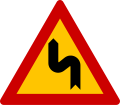 Κ-2α
Κ-2α
Double curve (left)
(formerly used or
or  )
)
-
 Κ-2δ
Κ-2δ
Double curve (right)
(formerly used or
or  )
)
-
 Κ-3
Κ-3
Steep hill downwards
(formerly used )
)
-
 Κ-4
Κ-4
Steep hill upwards -
 Κ-5
Κ-5
Road narrows
(formerly used )
)
-
 K-6α
K-6α
Road narrows on left -
 K-6δ
K-6δ
Road narrows on right -
 K-7
K-7
Moveable bridge
(formerly used )
)
-
 K-8
K-8
Quayside or river bank -
 K-9
K-9
Uneven road
(formerly used )
)
-
 K-10
K-10
Speed refluction bumps -
 K-11
K-11
Dip -
 K-12
K-12
Slippery road
(formerly used )
)
-
 K-13
K-13
Loose chippings -
 K-14
K-14
Rockfall from right -
 K-14
K-14
Rockfall from left -
 K-15
K-15
Pedestrian crossing ahead
(formerly used )
)
-
 K-16
K-16
Children -
 K-17
K-17
Cyclists -
 K-18
K-18
Domesticated animals
(formerly used )
)
-
 K-19
K-19
Wild animals -
 K-20
K-20
Roadworks
(formerly used )
)
-
 K-21
K-21
Traffic signals -
 K-22
K-22
Low-flying aircraft -
 K-23
K-23
Crosswind -
 K-23
K-23
Crosswind -
 K-24
K-24
Two-way traffic -
 K-25
K-25
Other danger
(formerly used )
)
-
 K-26
K-26
Intersection with priority to the right
(formerly used )
)
-
 K-27
K-27
Intersection with priority
(formerly used )
)
-
 K-28α
K-28α
Junction with a side-road from the left -
 K-28δ
K-28δ
Junction with a side-road from the right -
 K-29α
K-29α
Merging traffic from the left -
 K-29δ
K-29δ
Merging traffic from the right
(formerly used )
)
-
 K-30
K-30
Roundabout ahead -
 K-31
K-31
Level crossing with a barrier or gate
(formerly used )
)
-
 K-32
K-32
Level crossing without a barrier or gate
(formerly used )
)
-
 K-33
K-33
Distance to level crossing (farthest)
(formerly used )
)
-
 K-34
K-34
Distance to level crossing (middle)
(formerly used )
)
-
 K-35
K-35
Distance to level crossing (closest)
(formerly used )
)
-
 K-36
K-36
Single-track railway
(formerly used )
)
-
 K-37
K-37
Multi-track railway
(formerly used )
)
-
 K-38α
K-38α
Dangerous verges on the left -
 K-38δ
K-38δ
Dangerous verges on the right -
 K-39
K-39
Traffic queues -
 K-40
K-40
Tunnel ahead -
 K-41
K-41
Tramway -
 K-42
K-42
Fog -
 K-42α
K-42α
Fog -
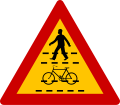 K-43
K-43
Parallel pedestrian and cyclist crossing -
 K-44
K-44
Common pedestrian and cyclist crossing -
 Κ-45α
Κ-45α
Steep hill downwards for cyclist -
 Κ-45δ
Κ-45δ
Steep hill upwards for cyclist
Source:
Regulatory signs (ΚΟΚ series Ρ)
The Ρ series of ΚΟΚ, includes prohibitive and mandatory signs. These signs have mostly a round shape (except for Ρ-1 to Ρ-4, Ρ-6, Ρ-43, Ρ-44, Ρ-60, Ρ-61, Ρ-69 to Ρ-75). Prohibitive signs have their borders red and their background white with the pictograms being black. For mandatory signs, their background is blue and the pictograms is white. These signs are affixed to inform drivers of obligations, restrictions or prohibitions.
-
 Ρ-1
Ρ-1
Give way
(formerly used )
)
-
 Ρ-2
Ρ-2
Stop
(formerly used )
)
-
 Ρ-3
Ρ-3
Priority road -
 Ρ-4
Ρ-4
End of priority road -
 Ρ-5
Ρ-5
Give priority to oncoming traffic -
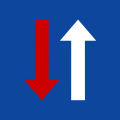 Ρ-6
Ρ-6
Priority over oncoming traffic -
 Ρ-7
Ρ-7
No entry
(formerly used )
)
-
 Ρ-8
Ρ-8
Road closed for all vehicles -
 Ρ-9
Ρ-9
No motor vehicles with 4 or more wheels -
 Ρ-10
Ρ-10
No motorcycles -
 Ρ-11
Ρ-11
No bicycles -
 Ρ-12
Ρ-12
No mopeds -
 Ρ-13
Ρ-13
No lorries -
 Ρ-14
Ρ-14
No vehicles with a trailer -
 Ρ-15
Ρ-15
No pedestrians -
 Ρ-16
Ρ-16
No animal-drawn vehicles -
 Ρ-17
Ρ-17
No handcarts -
 Ρ-18
Ρ-18
No agricultural machineries -
 Ρ-19
Ρ-19
No motor vehicles -
 Ρ-20
Ρ-20
No motor vehicles and animal-drawn vehicles -
 Ρ-21
Ρ-21
No vehicles over width shown (e.g. 2m) -
 Ρ-22
Ρ-22
No vehicles over height shown (e.g. 3.5m) -
 Ρ-23
Ρ-23
No vehicles over tonnes shown (e.g. 5t) -
 Ρ-24
Ρ-24
No vehicles over axle weight limit (e.g. 2t) -
 Ρ-25
Ρ-25
No vehicles over length shown (e.g. 10m) -
 Ρ-26
Ρ-26
Minimum distance (e.g. 70m) -
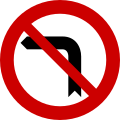 Ρ-27
Ρ-27
No left turn -
 Ρ-28
Ρ-28
No right turn -
 Ρ-29
Ρ-29
No U-turn -
 Ρ-30
Ρ-30
No overtaking
(formerly used or
or  )
)
-
 Ρ-31
Ρ-31
No overtaking from vehicles over 3.5 tonnes -
 Ρ-32α
Ρ-32α
Maximum speed (10 km/h) -
 Ρ-32β
Ρ-32β
Maximum speed (20 km/h) -
 Ρ-32γ
Ρ-32γ
Maximum speed (30 km/h) -
 Ρ-32δ
Ρ-32δ
Maximum speed (40 km/h) -
 Ρ-32ε
Ρ-32ε
Maximum speed (50 km/h) -
 Ρ-32στ
Ρ-32στ
Maximum speed (60 km/h) -
 Ρ-32ζ
Ρ-32ζ
Maximum speed (70 km/h) -
 Ρ-32η
Ρ-32η
Maximum speed (80 km/h) -
 Ρ-32θ
Ρ-32θ
Maximum speed (90 km/h) -
 Ρ-32ι
Ρ-32ι
Maximum speed (100 km/h) -
 Ρ-32κ
Ρ-32κ
Maximum speed (110 km/h) -
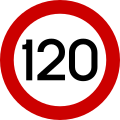 Ρ-32λ
Ρ-32λ
Maximum speed (120 km/h) -
 Ρ-32μ
Ρ-32μ
Maximum speed (130 km/h) -
 Ρ-33
Ρ-33
No use of horns -
 Ρ-34
Ρ-34
Customs control
(formerly used )
)
-
 Ρ-35
Ρ-35
Toll road -
 Ρ-36
Ρ-36
End of restriction -
 Ρ-37
Ρ-37
End of maximum speed (e.g. 60 km/h) -
 Ρ-38
Ρ-38
End of no overtaking -
 Ρ-39
Ρ-39
No parking
(formerly used or
or  )
)
-
 Ρ-40
Ρ-40
No parking and stopping -
 Ρ-41
Ρ-41
No parking on odd months
(formerly used )
)
-
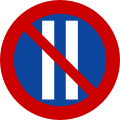 Ρ-42
Ρ-42
No parking on even months
(formerly used )
)
-
 Ρ-43
Ρ-43
No parking zone -
 Ρ-44
Ρ-44
End of no parking zone -
 Ρ-45
Ρ-45
No vehicles carrying explosives or flammable goods -
 Ρ-46
Ρ-46
No vehicles carrying goods which could pollute water -
 Ρ-47
Ρ-47
Turn left
(formerly used )
)
-
 Ρ-48
Ρ-48
Turn right
(formerly used )
)
-
 Ρ-49
Ρ-49
Keep straight
(formerly used )
)
-
 Ρ-50
Ρ-50
Turn left or right ahead
(formerly used )
)
-
 Ρ-50α
Ρ-50α
Turn left ahead
(formerly used )
)
-
 Ρ-50δ
Ρ-50δ
Turn right ahead
(formerly used )
)
-
 Ρ-51α
Ρ-51α
Turn straight or left ahead
(formerly used )
)
-
 Ρ-51δ
Ρ-51δ
Turn straight or right ahead
(formerly used )
)
-
 Ρ-52
Ρ-52
Cross either on left or right -
 Ρ-52α
Ρ-52α
Keep left
(formerly used )
)
-
 Ρ-52δ
Ρ-52δ
Keep right
(formerly used )
)
-
 Ρ-53
Ρ-53
Roundabout
(formerly used )
)
-
 Ρ-54
Ρ-54
Bicycle lane
(formerly used )
)
-
 Ρ-55
Ρ-55
Pedestrian lane (footpath)
(formerly used )
)
-
 Ρ-56
Ρ-56
Bridleway -
 Ρ-57
Ρ-57
Minimum speed (e.g. 30 km/h) -
 Ρ-58
Ρ-58
End of minimum speed (e.g. 30 km/h) -
 Ρ-59
Ρ-59
Snow chains compulsory -
 Ρ-60
Ρ-60
Maximum speed zone (e.g. 50 km/h) -
 Ρ-61
Ρ-61
End of maximum speed zone (e.g. 50 km/h) -
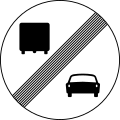 Ρ-62
Ρ-62
End of no overtaking from vehicles over 3.5 tonnes -
 Ρ-63
Ρ-63
No trailers over tonnes shown (e.g. 3t) -
 Ρ-64
Ρ-64
No vehicles carrying hazardous goods -
 Ρ-65
Ρ-65
Segregated pedestrian and bicycle path -
 Ρ-65
Ρ-65
Segregated pedestrian and bicycle path -
 Ρ-66
Ρ-66
Shared path from pedestrians and bicycles -
 Ρ-66α
Ρ-66α
Shared path from bicycles and vehicles -
 Ρ-67
Ρ-67
Exclusive bus or trolleybus crossing -
 Ρ-67α
Ρ-67α
Exclusive passage of buses, trolleybuses and bicycles -
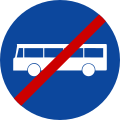 Ρ-68
Ρ-68
End of exclusive bus or trolleybus crossing -
 Ρ-68α
Ρ-68α
End of exclusive passage of buses, trolleybuses and bicycles -
 Ρ-69
Ρ-69
Controlled parking -
 Ρ-70
Ρ-70
Parking of a certain category of vehicles (e.g. TAXI) -
 Ρ-71
Ρ-71
Parking exclusively for vehicles of people with disabilities -
 Ρ-72
Ρ-72
Parking exclusively for vehicles of people with disabilities, with a special license -
 Ρ-73α
Ρ-73α
Vehicles carrying hazardous goods should turn left -
 Ρ-73δ
Ρ-73δ
Vehicles carrying hazardous goods should turn right -
 Ρ-74α
Ρ-74α
Vehicles carrying hazardous goods should turn left -
 Ρ-74δ
Ρ-74δ
Vehicles carrying hazardous goods should turn right -
 Ρ-75
Ρ-75
Attention to vehicles carrying goods which could pollute water -
 Ρ-76
Ρ-76
Exclusive tram crossing -
 Ρ-77
Ρ-77
End of exclusive tram crossing
Sources:
Information signs (ΚΟΚ series Π)
| This section needs expansion. You can help by adding to it. (December 2021) |
The Π series of ΚΟΚ, includes information signs. These signs are affixed to inform drivers of different kind of informations.
-
 Π-1
Π-1
Directions on an expressway -
 Π-2
Π-2
Directions on an expressway -
 Π-3
Π-3
Primary or secondary road direction -
 Π-3α
Π-3α
Direction to urban area -
 Π-3β
Π-3β
Direction to tourist attraction -
 Π-4
Π-4
Dead end on right -
 Π-5
Π-5
Dead end on left -
 Π-6
Π-6
Alternative direction -
 Π-7
Π-7
Multi-lane lane warning sign at an intersection -
 Π-8α
Π-8α
Primary or secondary road direction -
 Π-8β
Π-8β
Primary or secondary road direction -
 Π-8γ
Π-8γ
Primary or secondary road direction -
 Π-8δ
Π-8δ
Direction to tourist attraction -
 Π-9
Π-9
Primary or secondary road direction -
 Π-10
Π-10
Direction to the airport -
 Π-11
Π-11
-
 Π-12
Π-12
-
 Π-13 National Road number
Π-13 National Road number
-
 Π-14
Π-14
Motorway number -
 Π-15
Π-15
Street mileage -
 Π-16
Π-16
Street mileage -
 Π-17
Π-17
Beginning of residential area -
 Π-18
Π-18
End of residential area -
 Π-19
Π-19
Toponymy -
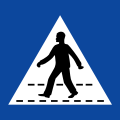 Π-21
Π-21
Pedestrian crossing -
 Π-21α
Π-21α
Cyclist crossing -
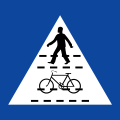 Π-21β
Π-21β
Parallel pedestrian and cyclist crossing -
 Π-21γ
Π-21γ
Pedestrian and cyclist crossing -
 Π-22
Π-22
Hospital
(formerly used )
)
-
 Π-23
Π-23
One-way street -
 Π-24
Π-24
One-way street (right) -
 Π-24
Π-24
One-way street (left) -
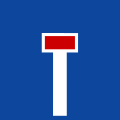 Π-25
Π-25
Dead end -
 Π-26
Π-26
Expressway -
 Π-26α
Π-26α
End of expressway -
 Π-27
Π-27
Motorway
(formerly used )
)
-
 Π-27α
Π-27α
End of motorway
(formerly used )
)
-
 Π-28
Π-28
Bus or trolleybus stop -
 Π-28α
Π-28α
Railway station -
 Π-29
Π-29
Information about road condition of passes -
 Π-30
Π-30
Snow chains or snow tyres are recommended (used on Π-29) -
 Π-31
Π-31
Parking place
(formerly used )
)
-
 Π-31α
Π-31α
Parking area -
 Π-31β
Π-31β
End of parking area -
 Π-31γ
Π-31γ
Direction to show parking area -
 Π-31δ
Π-31δ
Bicycle parking -
 Π-32
Π-32
First aid
(formerly used )
)
-
 Π-33
Π-33
Repairs
(formerly used )
)
-
 Π-34
Π-34
Telephone
(formerly used )
)
-
 Π-35
Π-35
Petrol station
(formerly used )
)
-
 Π-36
Π-36
Hotel or motel -
 Π-37
Π-37
Restaurant -
 Π-38
Π-38
Refreshments -
 Π-39
Π-39
Picnic site -
 Π-40
Π-40
Hiking trail -
 Π-41
Π-41
Camping site
(formerly used )
)
-
 Π-42
Π-42
Caravan site -
 Π-43
Π-43
Camping and caravan site -
 Π-44
Π-44
Youth hostel -
 Π-45
Π-45
Information -
 Π-46
Π-46
Bathing -
 Π-47
Π-47
Lavatory -
 Π-48
Π-48
Radio station for road and traffic information -
 Π-49
Π-49
Tunnel -
 Π-50
Π-50
Airport -
 Π-51
Π-51
Helicopter -
 Π-52
Π-52
Cable car -
 Π-53
Π-53
Seaport -
 Π-54
Π-54
Tourist port -
 Π-55
Π-55
Port for hydrofoils -
 Π-56
Π-56
Seaport for ferry -
 Π-57
Π-57
Police -
 Π-58
Π-58
Urban area -
 Π-59
Π-59
End of urban area -
 Π-60
Π-60
Disabled people -
 Π-61
Π-61
Pedestrian overpass -
 Π-62
Π-62
Pedestrian underpass -
 Π-63
Π-63
Pedestrian ramp -
 Π-64
Π-64
Advisory speed limit -
 Π-65
Π-65
General speed limits -
 Π-66
Π-66
-
 Π-67
Π-67
-
 Π-68
Π-68
-
 Π-68
Π-68
-
 Π-69
Π-69
-
 Π-69
Π-69
-
 Π-69α
Π-69α
-
 Π-70
Π-70
-
 Π-70α
Π-70α
-
 Π-71
Π-71
Lavatory for people with disabilities -
 Π-72
Π-72
-
 Π-73
Π-73
-
 Π-74
Π-74
Obstacle marker (left) -
 Π-74
Π-74
Obstacle marker (right) -
 Π-75
Π-75
Sharp bend, left -
 Π-75
Π-75
Sharp bend, right -
 Π-76
Π-76
Barrier marker -
 Π-76
Π-76
Barrier marker -
 Π-77
Π-77
Obstacle marker (keep right) -
 Π-78
Π-78
Obstacle marker (keep left) -
 Π-79
Π-79
Cross either on left or right -
 Π-80
Π-80
Interchange -
 Π-81
Π-81
-
 Π-82
Π-82
-
 Π-83
Π-83
-
 Π-84
Π-84
-
 Π-85
Π-85
-
 Π-86
Π-86
Exit -
 Π-89
Π-89
-
 Π-90α
Π-90α
Distance marker before an exit (300 m) -
 Π-90β
Π-90β
Distance marker before an exit (200 m) -
 Π-90γ
Π-90γ
Distance marker before an exit (100 m) -
 Π-91
Π-91
Vehicles that carry more than a certain amount of explosives or flammable substances should use the exit -
 Π-92
Π-92
Traffic calming zone -
 Π-92α
Π-92α
End of traffic calming zone -
 Π-93
Π-93
Pedestrian crossing patrol -
 Π-94
Π-94
Stopping and parking is prohibited, owner's vehicle will be towed -
 Π-94
Π-94
Stopping and parking is prohibited, owner's vehicle will be towed -
 Π-95
Π-95
Tram on road -
 Π-97
Π-97
-
 Π-98
Π-98
-
 Π-98α
Π-98α
-
 Π-133
Π-133
Fire extinguisher -
 Π-134α
Π-134α
Emergency layby -
 Π-134β
Π-134β
Emergency layby
Sources:
Additional signs (ΚΟΚ series Πρ)
| This section needs expansion. You can help by adding to it. (December 2021) |
These signs are rectangular with a black border on a white background with a black pictogram and are always combined with other road signs. Additional signs are never used by themselves.
-
 Πρ-1
Πρ-1
100 m ahead -
 Πρ-2
Πρ-2
Length of a danger -
 Πρ-4α
Πρ-4α
Beginning of...
(formerly used )
)
-
 Πρ-4β
Πρ-4β
Continual of...
(formerly used )
)
-
 Πρ-4γ
Πρ-4γ
End of...
(formerly used )
)
-
 Πρ-4δ
Πρ-4δ
ΑμεΑ vehicles -
 Πρ-4ε
Πρ-4ε
No ΑμεΑ vehicles -
 Πρ-5
Πρ-5
Risk of snow/ice -
 Πρ-6
Πρ-6
Rain -
 Πρ-7
Πρ-7
Direction of priority road -
 Πρ-8
Πρ-8
Direction of priority road -
 Πρ-9
Πρ-9
Direction of priority road -
 Πρ-10
Πρ-10
Direction of priority road -
 Πρ-11
Πρ-11
Direction of priority road -
 Πρ-12
Πρ-12
Direction of priority road -
 Πρ-13
Πρ-13
Direction of priority road -
 Πρ-14α
Πρ-14α
Hard curve (left) -
 Πρ-14δ
Πρ-14δ
Hard curve (right) -
 Πρ-15α
Πρ-15α
-
 Πρ-15δ
Πρ-15δ
-
 Πρ-16α
Πρ-16α
Animal-drawn vehicle -
 Πρ-16β
Πρ-16β
Handcart -
 Πρ-16γ
Πρ-16γ
Bicycle -
 Πρ-16δ
Πρ-16δ
Moped -
 Πρ-16ε
Πρ-16ε
Motorcycle -
 Πρ-16στ
Πρ-16στ
Passenger vehicle -
 Πρ-16ζ
Πρ-16ζ
Passenger vehicle with a trailer -
 Πρ-16η
Πρ-16η
Agricultural machinery -
 Πρ-16θ
Πρ-16θ
Bus or trolleybus -
 Πρ-16ι
Πρ-16ι
Lorry -
 Πρ-16ια
Πρ-16ια
Semi-trailer truck -
 Πρ-16ιβ
Πρ-16ιβ
Semi-trailer truck with a trailer -
 Πρ-16ιγ
Πρ-16ιγ
Lorry with a trailer -
 Πρ-16ιδ
Πρ-16ιδ
Vehicle carrying explosives or flammable goods -
 Πρ-16ιε
Πρ-16ιε
Tram -
 Πρ-17 (α-ιδ)
Πρ-17 (α-ιδ)
No bus or trolleybus -
 Πρ-18α
Πρ-18α
TAXI -
 Πρ-18β
Πρ-18β
Except TAXI
Sources:
Temporary signs
| This section needs expansion. You can help by adding to it. (December 2021) |
Temporary signs typically consist of a traffic sign placed on an orange background.
-
 Κ-1α
Κ-1α
Curve (left) -
 Κ-1δ
Κ-1δ
Curve (right) -
 Κ-2α
Κ-2α
Double curve (left) -
 Κ-2δ
Κ-2δ
Double curve (right) -
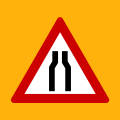 Κ-5
Κ-5
Road narrows -
 Κ-6α
Κ-6α
Road narrows on left -
 Κ-6δ
Κ-6δ
Road narrows on right -
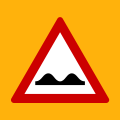 Κ-9
Κ-9
Uneven road -
 Κ-10
Κ-10
Humps -
 Κ-11
Κ-11
Dip -
 Κ-12
Κ-12
Slippery road -
 Κ-13
Κ-13
Loose chippings -
 Κ-15
Κ-15
Pedestrian crossing ahead -
 Κ-16
Κ-16
Children -
 Κ-20
Κ-20
Roadworks -
 Κ-21
Κ-21
Traffic signals -
 Κ-24
Κ-24
Two-way traffic -
 Κ-25
Κ-25
Other danger -
 Κ-26
Κ-26
Intersection with priority to the right -
 Κ-27
Κ-27
Intersection with priority -
 Κ-28α
Κ-28α
Junction with a side-road from the left -
 Κ-28δ
Κ-28δ
Junction with a side-road from the right -
 Κ-29α
Κ-29α
Merging traffic from the left -
 Κ-29δ
Κ-29δ
Merging traffic from the right -
 Κ-30
Κ-30
Roundabout ahead -
 Κ-42
Κ-42
Fog -
 Ρ-1
Ρ-1
Give way -
 Ρ-2
Ρ-2
Stop -
 Ρ-5
Ρ-5
Give priority to oncoming traffic -
 Ρ-6
Ρ-6
Priority over oncoming traffic -
 Ρ-7
Ρ-7
No entry -
 Ρ-8
Ρ-8
Road closed for all vehicles -
 Ρ-8
Ρ-8
Road closed for all vehicles except for construction site vehicles -
 Ρ-13
Ρ-13
No lorries -
 Ρ-14
Ρ-14
No vehicles with a trailer -
 Ρ-15
Ρ-15
No pedestrians -
 Ρ-27
Ρ-27
No left turn -
 Ρ-28
Ρ-28
No right turn -
 Ρ-29
Ρ-29
No U-turn -
 Ρ-30
Ρ-30
No overtaking -
 Ρ-31
Ρ-31
No overtaking from vehicles over 3.5 tonnes -
 Ρ-32α
Ρ-32α
Maximum speed (10 km/h) -
 Ρ-32β
Ρ-32β
Maximum speed (20 km/h) -
 Ρ-32γ
Ρ-32γ
Maximum speed (30 km/h) -
 Ρ-32δ
Ρ-32δ
Maximum speed (40 km/h) -
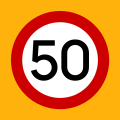 Ρ-32ε
Ρ-32ε
Maximum speed (50 km/h) -
 Ρ-32στ
Ρ-32στ
Maximum speed (60 km/h) -
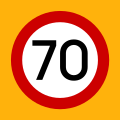 Ρ-32ζ
Ρ-32ζ
Maximum speed (70 km/h) -
 Ρ-32η
Ρ-32η
Maximum speed (80 km/h) -
 Ρ-36
Ρ-36
End of restriction -
 Ρ-38
Ρ-38
End of no overtaking -
 Ρ-39
Ρ-39
No parking -
 Ρ-40
Ρ-40
No parking and stopping -
 Ρ-49
Ρ-49
Keep straight -
 Ρ-50
Ρ-50
Turn left or right ahead -
 Ρ-50α
Ρ-50α
Turn left ahead -
 Ρ-50δ
Ρ-50δ
Turn right ahead -
 Ρ-51α
Ρ-51α
Turn straight or left ahead -
 Ρ-51δ
Ρ-51δ
Turn straight or right ahead -
 Ρ-52
Ρ-52
Cross either on left or right -
 Ρ-52α
Ρ-52α
Keep left -
 Ρ-52δ
Ρ-52δ
Keep right -
 Ρ-62
Ρ-62
End of no overtaking from vehicles over 3.5 tonnes -
 Π-21
Π-21
Pedestrian crossing -
 Π-23
Π-23
One-way street -
 Π-25
Π-25
Dead end -
 Π-75
Π-75
Obstacle marker (left) -
 Π-75
Π-75
Obstacle marker (right) -
 Π-75
Π-75
Obstacle marker (left) -
 Π-75
Π-75
Obstacle marker (right) -
 Π-70
Π-70
Temporary right lane closed ahead -
 Π-103
Π-103
Temporary onto opposite lane (200 m) -
 N/A
N/A
Caution, roadworks -
 N/A
N/A
Slow -
 N/A
N/A
Caution, entry-exit of construction site -
 N/A
N/A
Except construction vehicles -
 N/A
N/A
Diversion -
 N/A
N/A
Diversion -
 Π-9
Π-9
Direction -
 N/A
N/A
End of roadworks from metro -
 N/A
N/A
Risk of falling -
 N/A
N/A
Movable trailer with flashers and a big arrow to indicate drivers where to go -
 N/A
N/A
Movable trailer with flashers and a big arrow to indicate drivers where to go
Sources:
Other signs
| This section needs expansion. You can help by adding to it. (January 2022) |
(This section needs more information) These signs are unofficial.
-
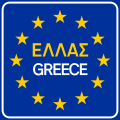 N/A
N/A
Border crossing -
 Κ-16
Κ-16
Children -
 Ρ-32γ
Ρ-32γ
Maximum speed (30 km/h) -
 Π-21
Π-21
Pedestrian crossing -
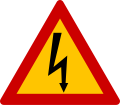 N/A
N/A
Electrical hazard -
 N/A
N/A
Pedestrians -
 N/A
N/A
No lorries over tonnes shown (e.g. 6t) -
 N/A
N/A
No buses -
 N/A
N/A
No lorries and buses -
 N/A
N/A
No lorries turn left -
 N/A
N/A
No lorries turn right -
 N/A
N/A
Control -
 Ρ-39
Ρ-39
No parking -
 N/A
N/A
No parking with arrows -
 N/A
N/A
No parking due to school -
 N/A
N/A
Start of no parking -
 N/A
N/A
End of no parking -
 N/A
N/A
Start of no parking and stopping -
 N/A
N/A
End of no parking and stopping -
 N/A
N/A
Vehicles of disabled lane -
 N/A
N/A
Motor vehicles lane -
 N/A
N/A
Lorries lane -
 N/A
N/A
Continuous pedestrian crossings -
 N/A
N/A
Children crossing -
 N/A
N/A
Speed bump -
 N/A
N/A
Caution, school -
 N/A
N/A
Caution, children are playing -
 N/A
N/A
Caution, children are playing -
 N/A
N/A
Left and right -
 N/A
N/A
Traffic camera -
 N/A
N/A
Direction to the Acropolis museum -
 N/A
N/A
Direction to the airport -
 N/A
N/A
Stop ahead
Road markings
-
 N/A
N/A
Keep straight -
 N/A
N/A
Turn straight, left or right ahead -
 N/A
N/A
Turn straight or left ahead -
 N/A
N/A
Turn straight or right ahead -
 N/A
N/A
Turn left or right ahead -
 N/A
N/A
Keep left -
 N/A
N/A
Keep right
Obsolete signs
| This section needs expansion. You can help by adding to it. (December 2021) |
Most of these signs are withdrawn or replaced with new diagrams of the same meaning, except for some which are entirely obsolete.
-
 Κ-1α
Κ-1α
Curve (left) -
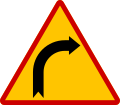 Κ-1δ
Κ-1δ
Curve (right) -
 Κ-2
Κ-2
Double curve -
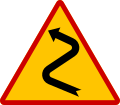 Κ-2
Κ-2
Double curve -
 Κ-3
Κ-3
Steep hill downwards -
 Κ-5
Κ-5
Road narrows -
 K-7
K-7
Moveable bridge -
 K-9
K-9
Uneven road -
 K-12
K-12
Slippery road -
 K-15
K-15
Pedestrian crossing ahead -
 K-18
K-18
Domesticated animals -
 K-20
K-20
Roadworks -
 K-25
K-25
Other danger -
 K-26
K-26
Intersection with priority to the right -
 K-27
K-27
Intersection with priority -
 K-29δ
K-29δ
Merging traffic from the right -
 K-31
K-31
Level crossing with a barrier or gate -
 K-32
K-32
Level crossing without a barrier or gate -
 N/A
N/A
Piraeus-Perama level crossing -
 K-33
K-33
Distance to level crossing (farthest) -
 K-34
K-34
Distance to level crossing (middle) -
 K-35
K-35
Distance to level crossing (closest) -
 K-36
K-36
Single-track railway -
 K-37
K-37
Multi-track railway -
 N/A
N/A
Attention to the trains -
 Ρ-1
Ρ-1
Give way -
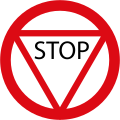 Ρ-2
Ρ-2
Stop -
 Ρ-7
Ρ-7
No entry -
 Ρ-30
Ρ-30
No overtaking (cars) -
 Ρ-30
Ρ-30
No overtaking (arrows) -
 Ρ-34
Ρ-34
Customs control -
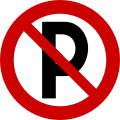 Ρ-39
Ρ-39
No parking -
 Ρ-39
Ρ-39
No parking -
 Ρ-41
Ρ-41
No parking on odd months -
 Ρ-42
Ρ-42
No parking on even months -
 Ρ-47
Ρ-47
Turn left -
 Ρ-48
Ρ-48
Turn right -
 Ρ-49
Ρ-49
Keep straight -
 Ρ-50
Ρ-50
Turn left or right ahead -
 P-50α
P-50α
Turn left ahead -
 P-50δ
P-50δ
Turn right ahead -
 P-51α
P-51α
Turn straight or left ahead -
 P-51δ
P-51δ
Turn straight or right ahead -
 P-52α
P-52α
Keep left -
 P-52δ
P-52δ
Keep right -
 P-53
P-53
Roundabout -
 P-54
P-54
Bicycle lane -
 P-55
P-55
Pedestrian lane (footpath) -
 N/A
N/A
Obligatory run of the depicted vehicle -
 N/A
N/A
Special direction & distance sign of the vehicle shown in the white space -
 N/A
N/A
Slow -
 Π-22
Π-22
Hospital -
 Π-27
Π-27
Motorway -
 Π-27α
Π-27α
End of motorway -
 Π-31
Π-31
Parking place -
 Π-32
Π-32
First aid -
 Π-33
Π-33
Reparis -
 Π-34
Π-34
Telephone -
 Π-35
Π-35
Petrol station -
 Π-41
Π-41
Camping site -
 N/A
N/A
Parking lot for caravans -
 Πρ-4α
Πρ-4α
Beginning of... -
 Πρ-4β
Πρ-4β
Continual of... -
 Πρ-4γ
Πρ-4γ
End of... -
 N/A
N/A
Risk of fire -
 N/A
N/A
Progressive load indications -
 N/A
N/A
No parking, trolleybus crosses -
 N/A
N/A
Δήμος Νέας Πεντέλης
Sources:
Athens bus service signs
-

-
 "No parking. Bus passing". Athens Urban Transport (OASA) and Thermal Bus Company (ETHEL) road sign.
"No parking. Bus passing". Athens Urban Transport (OASA) and Thermal Bus Company (ETHEL) road sign.
-
 "No parking. Bus passing". Athens Urban Transport (OASA) and Thermal Bus Company (ETHEL) road sign.
"No parking. Bus passing". Athens Urban Transport (OASA) and Thermal Bus Company (ETHEL) road sign.
-
 "Bus passing. Illegally parked vehicles will be towed". Athens Urban Transport (OASA) and Thermal Bus Company (ETHEL) new road sign.
"Bus passing. Illegally parked vehicles will be towed". Athens Urban Transport (OASA) and Thermal Bus Company (ETHEL) new road sign.
-
 Left arrow - Athens Urban Transport (OASA) guidance sign (with route label).
Left arrow - Athens Urban Transport (OASA) guidance sign (with route label).
-
 Forward arrow - Athens Urban Transport (OASA) guidance (without route label).
Forward arrow - Athens Urban Transport (OASA) guidance (without route label).
-
 Right arrow - Athens Urban Transport (OASA) guidance (without route label).
Right arrow - Athens Urban Transport (OASA) guidance (without route label).
-
 Old Athens bus stop sign (OASA-ETHEL) circa 1994–2005.
Old Athens bus stop sign (OASA-ETHEL) circa 1994–2005.
-
 Recent Athens bus stop sign (OASA-ETHEL) circa 2005–2015.
Recent Athens bus stop sign (OASA-ETHEL) circa 2005–2015.
-
 Most recent Athens bus stop sign (OASA-OSY) since 2015 circa.
Most recent Athens bus stop sign (OASA-OSY) since 2015 circa.
References
- "United Nations Treaty Collection". treaties.un.org. Retrieved 2023-12-10.
- ^ "Πρότυπα σήμανσης και εξοπλισμού οδών" (PDF). Ενημερωτικό δελτίου Τ.Ε.Ε. (in Greek) (Τεύχος 1980). 14 November 1997.
- "Πρότυπα σήμανσης και εξοπλισμού οδών" (PDF). Ενημερωτικό δελτίου Τ.Ε.Ε. (in Greek) (Τεύχος 1980). 14 November 1997.
- "Σήμανση οδών" (PDF) (in Greek).
- "ΕΛΠΑ - Ελληνική Λέσχη Αυτοκινήτου και Περιηγήσεων" (in Greek). 2014-07-07. Archived from the original on 2014-07-07. Retrieved 2019-09-17.
- ^ "Σήμανση οδών" (PDF) (in Greek).
- ΛΑΓΓΙΩΤΗΣ, ΧΡ.; ΞΕΠΑΠΑΔΑΚΟΣ, ΔΗΜ. (28 January 1976). ΛΑΓΓΙΩΤΗΣ, ΧΡΙΣΤΟΔ. (ed.). "ΠΡΟΔΙΑΓΡΑΦΗ ΠΟΙΟΤΗΤΟΣ ΜΗ ΑΝΤΑΝΑΚΛΑΣΤΙΚΩΝ ΠΙΝΑΚΙΔΩΝ ΕΞ ΑΛΟΥΜΙΝΙΟΥ, ΔΙΑ ΤΗΝ ΣΗΜΑΝΣΙΝ ΟΔΩΝ". ΕΦΙΜΕΡΙΣ ΤΗΣ ΚΥΒΕΡΝΗΣΕΩΣ ΤΗΣ ΕΛΛΗΝΙΚΗΣ ΔΗΜΟΚΡΑΤΙΑΣ (in Greek) (ΦΕΚ 99/Β). ΕΝ ΑΘΗΝΑΙΣ.
- ΠΑΠΑΚΡΙΘΟΠΟΥΛΟΣ, ΙΔ. (1980-04-22). "ΠΑΠΑΚΡΙΘΟΠΟΥΛΟΣ". ΕΦΙΜΕΡΙΣ ΤΗΣ ΚΥΒΕΡΝΗΣΕΩΣ (in Greek) (ΦΕΚ 1061 Β΄/1980). Αθήναι.
- ^ Τσανακτσίδης, Δημήτριος; Τσιτσούλας, Δημήτριος. "Σήμανση οδών" (PDF) (in Greek).
- "Νέα πινακίδα του Κ.Ο.Κ. για την ομίχλη". autotriti.gr (in Greek).
- "Τροποποίηση του Κ.Ο.Κ. νέες πινακίδες κατακόρυφης σήμανσης". drivenews.gr (in Greek). 10 April 2018.
- "Τροποποίηση του Κ.Ο.Κ. νέες πινακίδες κατακόρυφης σήμανσης". drivenews.gr (in Greek). 10 April 2018.
- ^ Κώδικας Οδικής Κυκλοφορίας - Κ.Ο.Κ. - άτυπη κωδικοποίηση (PDF) (in Greek). iNomoi. February 2012.
- "Κώδικας-Οδικής-Κυκλοφορίας.pdf ministryofjustice.gr" (PDF) (in Greek). ΙΣΟΚΡΑΤΗΣ ΤΡΑΠΕΖΑ ΝΟΜΙΚΩΝ ΠΛΗΡΟΦΟΡΙΩΝ ΔΣΑ.
- "Κώδικας-Οδικής-Κυκλοφορίας.pdf ministryofjustice.gr" (PDF) (in Greek). ΙΣΟΚΡΑΤΗΣ ΤΡΑΠΕΖΑ ΝΟΜΙΚΩΝ ΠΛΗΡΟΦΟΡΙΩΝ ΔΣΑ.
- "Κώδικας-Οδικής-Κυκλοφορίας.pdf ministryofjustice.gr" (PDF) (in Greek). ΙΣΟΚΡΑΤΗΣ ΤΡΑΠΕΖΑ ΝΟΜΙΚΩΝ ΠΛΗΡΟΦΟΡΙΩΝ ΔΣΑ.
- "Κώδικας-Οδικής-Κυκλοφορίας.pdf ministryofjustice.gr" (PDF) (in Greek). ΙΣΟΚΡΑΤΗΣ ΤΡΑΠΕΖΑ ΝΟΜΙΚΩΝ ΠΛΗΡΟΦΟΡΙΩΝ ΔΣΑ.
- "Κώδικας-Οδικής-Κυκλοφορίας.pdf ministryofjustice.gr" (PDF) (in Greek). ΙΣΟΚΡΑΤΗΣ ΤΡΑΠΕΖΑ ΝΟΜΙΚΩΝ ΠΛΗΡΟΦΟΡΙΩΝ ΔΣΑ.
| Traffic signs | |||||||||||||||
|---|---|---|---|---|---|---|---|---|---|---|---|---|---|---|---|
| Signs |
| ||||||||||||||
| By country |
| ||||||||||||||
| Lights | |||||||||||||||
| Typefaces | |||||||||||||||
| International conventions |
| ||||||||||||||
| National standards | |||||||||||||||
| Comparisons | |||||||||||||||
| Road signs in Europe | |
|---|---|
| Sovereign states |
|
| States with limited recognition | |
| Dependencies and other entities | |